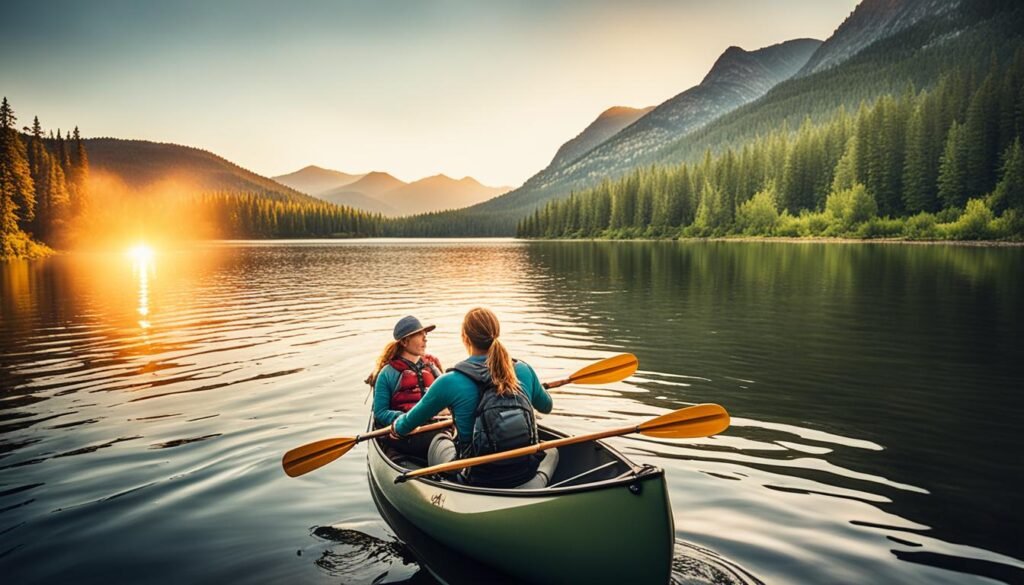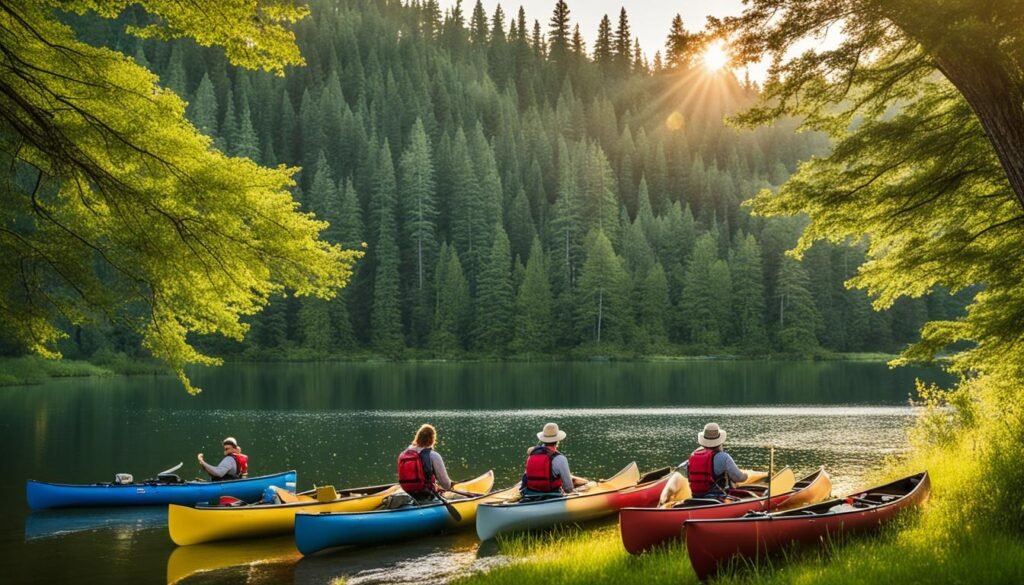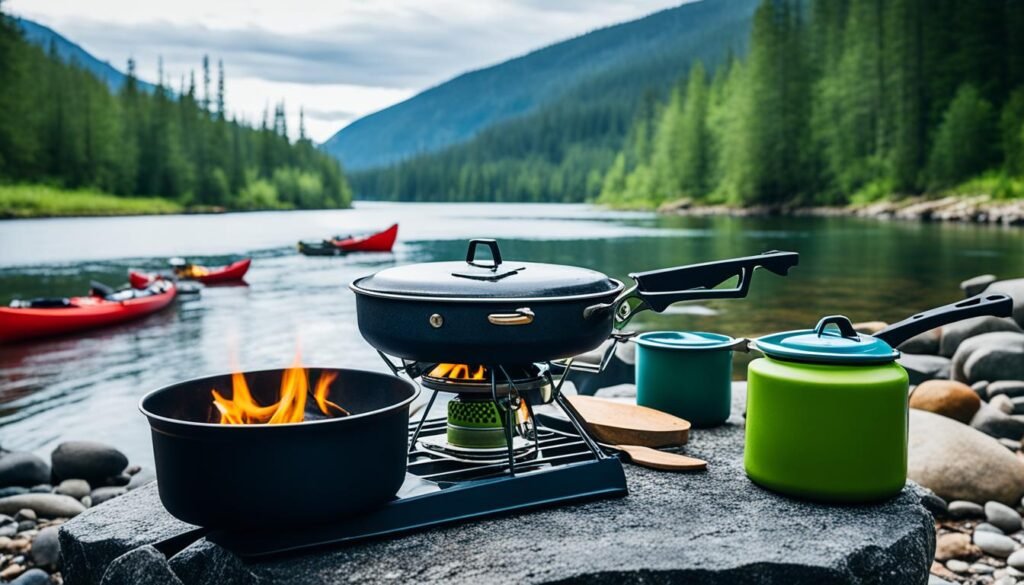Canoe camping is an exciting outdoor activity. It mixes camping fun with the calm of moving through beautiful waterways. Picture yourself moving quietly on lovely lakes and rivers, surrounded by nature. This is the essence of canoe camping.
Canoes have been around for centuries, used for travel and discovery. Native people used canoes to move along rivers, meet other groups, and discover new places. Now, canoe camping lets us get close to nature and feel adventurous.
Going on a canoe camping trip means you’re in charge. By day, you paddle on smooth waters and enjoy the lovely views. Come night, you camp by the riverside or at special camping spots, close to the wild.
Canoe camping takes you away from everyday noise. It lets you leave gadgets behind and connect with yourself, friends, and nature.
Are you ready for a canoe adventure? Let’s learn more about skills needed, paddling, finding your way, carrying your canoe, handling emergencies, and how to pack.
Key Takeaways:
- Canoe camping combines camping with the excitement of navigating through waterways.
- It allows you to disconnect from technology and immerse yourself in nature.
- Canoe camping requires specific skills such as paddling, navigation, and portaging.
- Paddling efficiently is crucial for conserving energy and maneuvering the canoe.
- Navigation skills are essential for staying on course and finding campsites.
What Skills Do Canoe Campers Need?
Canoe camping is an outdoor adventure that needs special skills. These skills help make sure you’re safe and having fun. Whether you are starting out or have lots of experience, learning these abilities is key. They are vital for moving through water and handling surprises.
Paddling
Paddling well is crucial for canoe campers. It helps you save energy, steer the canoe right, and handle different water types. Sitting correctly and holding the paddle well is important. This makes sure you paddle efficiently and control the canoe.
Knowing how to do various paddle strokes is also necessary. It lets you deal with wind and currents. Plus, it’s key for staying balanced and working with your partners. This teamwork makes the trip better.
Portaging
Portaging means carrying the canoe by land between water paths. It calls for strength, stamina, and smart judgement. You need to know how to bear the canoe’s weight well. It’s also crucial to walk steadily on rough ground.
Packing stuff in a way that makes portaging easier is critical too. This lowers the effort needed and makes moving smoother. With good portaging skills, you can easily go from water to land. This opens up new areas to explore.
Navigation
Being good at navigation helps you stick to your path and reach places you aim for. Canoe campers should know how to use a compass and read maps. Recognizing landmarks and understanding the map’s details is vital. This makes sure you go the right way and avoid dangers.
It’s also helpful to understand the water’s flow, tides, and weather. This knowledge lets you plan better and make smart choices. Good navigation skills make you confident. They let you enjoy nature’s beauty to the fullest.
Emergency Response
Being ready for sudden troubles is essential in canoe camping. Learning how to respond to emergencies keeps everyone safe. You should know basic first aid, how to handle cold, and do CPR if needed. Knowing rescue methods and how to use tools like GPS helps lots in wild places.
Having these emergency skills gives you and your group peace of mind. It lets you enjoy the adventure fully. You’ll be prepared for whatever comes up.
Learning these skills will set you up for amazing canoe camping trips. From smooth paddling and finding your way to being ready for any emergency, each skill is important. They make sure you have a safe and wonderful time in the wild.
Paddling and its Importance in Canoe Camping
Paddling is a key skill in canoe camping. It helps you move the canoe, stay stable, and handle different waters. Good paddling means control and safety.
Start with the right seating. Sit straight, knees bent, and feet flat in the canoe. This helps you control the canoe better. Keep your weight and gear balanced to avoid tipping.
How you hold the paddle matters. Keep your hands shoulder-width apart for better control. Make sure the curved side of the paddle faces away.
To move forward, dip the paddle deep and pull back. This creates power and speed. Turning requires a sweeping stroke with the paddle.
Mastering paddling helps in different waters. Whether it’s calm lakes or windy open water, good skills keep you safe. They let you adapt to any condition.
In tough weather, skilled paddling is vital. It keeps you stable and moving in strong winds or rough waters. Practice these skills before your trip to build confidence.
Paddling also brings campers together. Working in sync makes the canoe move smoothly. It creates teamwork and shared fun.
Good paddling is at the center of canoe camping. It lets you see beautiful places and enjoy nature. With the right techniques, your journey will be safe and fun.
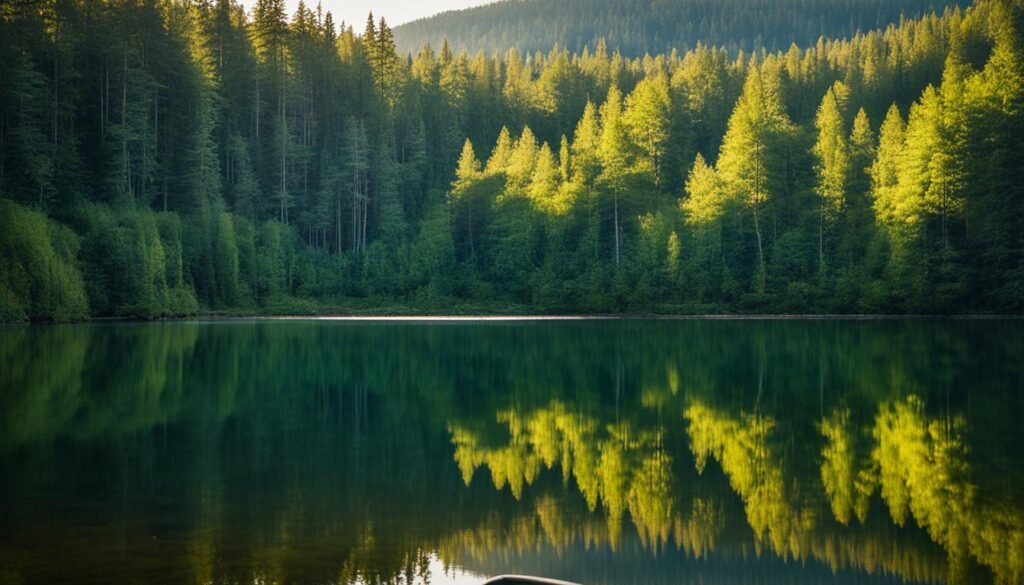
Navigation in Canoe Camping
Navigation is super important for canoe camping trips. It helps you stay on track and reach where you want to go. When you’re out on a river or a big lake, knowing how to navigate is key.
A map is a must-have tool for canoe campers. It lets you find campsites, portage trails, and get through new waters. A good map tells you about water conditions, what the land looks like, and what to watch out for.
Don’t forget about the compass. It’s a simple tool but it tells you which way to go. With a compass, you can make sure you’re reading the map right. You’ll know the best ways to get to your spots.
Seeing landmarks is also super important. Things like mountains, islands, or big trees help guide you. When you use maps, a compass, and spot landmarks, you won’t get lost. Even in places far from home.
There are special tricks for canoe campers too. Dead reckoning is one of them. It means guessing where you are based on where you’ve been, how far you paddled, and what’s around you. It works well when you use it with your map and compass.
To wrap it up, being good at navigation makes canoe camping better. It’s all about knowing where you are and where you’re going. So, learn to use maps, compasses, and landmarks. Whether it’s a quick trip or a long adventure, good navigation skills make the trip better.
Essential Navigation Tools for Canoe Camping
| Navigation Tools | Description |
|---|---|
| Map | A detailed representation of the waterways, campsites, and landmarks in the area. |
| Compass | A tool for determining direction and maintaining a steady course. |
| Landmarks | Distinctive features in the landscape that serve as reference points for navigation. |
| Dead Reckoning | A technique that estimates position based on previous location, paddling distance, and environmental factors. |
Portaging in Canoe Camping
Portaging is a key skill in canoe camping. It lets campers move their canoes and gear between waters. When there’s no water to navigate, portaging is a must to keep going. It takes strength, stamina, and smart thinking to tackle terrains like mud, rocks, or thick bushes.
During a portage, carrying all gear and keeping your balance is crucial. Even weight distribution and using the right lift technique help avoid injury. Being able to carry the canoe well is key for a good canoe camping trip.
Portaging tests your body and mind. It’s about being tough and focused as you face tough terrains and hurdles. Loving this challenge makes the adventure better and connects you deeper with nature.
Getting good at portaging takes practice and learning. Think about classes or advice from experts to learn how to do it right. Knowing each portage trail’s needs and the right equipment, like portage pads, helps a lot.
Portaging lets campers see how we connect with nature. It celebrates the history of canoe travel. By portaging, campers feel proud, rely on themselves, create memories, and grow a love for nature’s beauty.
Related Quotes:
“Portaging is more than carrying a canoe; it takes you back in time. It connects you with the history of canoeing.”
“Portaging challenges your body and mind. It moves you out of your comfort zone, revealing what you can do.”
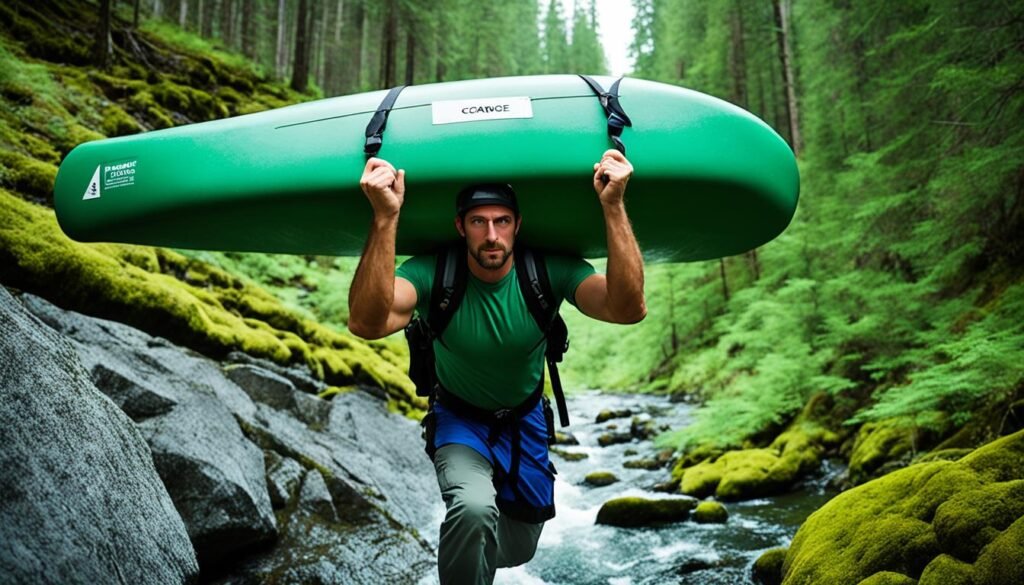
Emergency Response in Canoe Camping
Going on a canoe camping trip is exciting. But remember, the wilderness has risks. This could be from a canoe flipping to getting cold or hurt. To keep everyone safe, you need a plan for emergencies.
You should pack some essential items. A first aid kit is a must for small injuries. Also, a GPS satellite messenger could save your life in far places. It lets you call for help and tell them where you are.
Knowing what to do is just as important. Learn how to deal with a flipped canoe. Know how to give first aid and spot early signs of getting too cold. This knowledge can save lives and keep the trip safe.
Emergencies are hard to predict, but you can be smarter about where you camp. Places like the Superior National Forest are safer. They have set safety steps and help handy.
Being ready and knowing what to do are key for a great canoe camping trip.
| Emergency Response Tips for Canoe Camping |
|---|
| 1. Pack a comprehensive first aid kit, including items such as bandages, antiseptic ointment, and pain relievers. |
| 2. Carry a GPS satellite messenger to send emergency signals and share your exact location with rescue services. |
| 3. Learn and practice essential first aid skills, including CPR and treating fractures or sprains. |
| 4. Familiarize yourself with the signs of hypothermia and take appropriate measures to prevent or treat it. |
| 5. Research and choose canoe camping areas with established safety protocols and resources, like the Superior National Forest. |
Preparing for a Canoe Camping Trip – Packing and Planning
Planning and packing right are key for a great canoe camping trip. Make sure you have all you need. Use dry bags, backpacks, or barrels to keep your stuff dry.
Don’t forget your packing essentials like your canoe, paddles, and life jackets. These are important for staying safe on the water. Include a first aid kit, a map and compass, and the right clothes for the weather conditions.
Good pre-trip planning also matters a lot. Pick the right place that fits what you like and can do. If needed, book your spot or get permits early. Think about how hard and far your trip will be. This helps you get ready for what’s coming.
For more tips, look at this guide on planning and packing for a Northern Forest Canoe Trail trip. It has great info to help you enjoy your adventure. With the right prep and packing, you’ll have a fun and unforgettable trip.
FAQ
What is canoe camping?
Canoe camping means going on a camping trip for several days using a canoe. You experience camping excitement and the calm of water travel.
What skills do canoe campers need?
Canoe campers must know how to paddle, carry their canoe over land, find their way, and handle emergencies.
Why is paddling important in canoe camping?
Paddling helps move and steer the canoe right. It keeps you safe in different waters and bad weather.
How important is navigation in canoe camping?
Navigation helps keep your trip on track. It ensures you don’t get lost while traveling on water.
What is portaging and why is it necessary in canoe camping?
Portaging means carrying your canoe on land to move between waters. It’s needed to keep your journey going smoothly.
Why is emergency response important in canoe camping?
Campers must be ready for surprises, like if your canoe tips over, someone gets hurt, or it gets too cold.
What should I pack and plan for a canoe camping trip?
It’s vital to plan and pack well. Bring dry bags, paddling tools, and safety items. Think about your trip spot, its challenges, and the weather.

